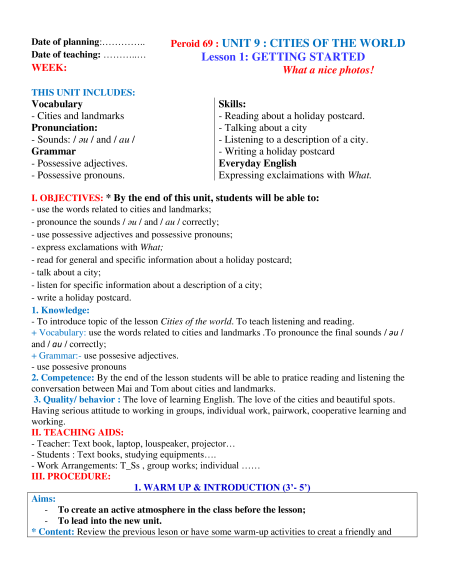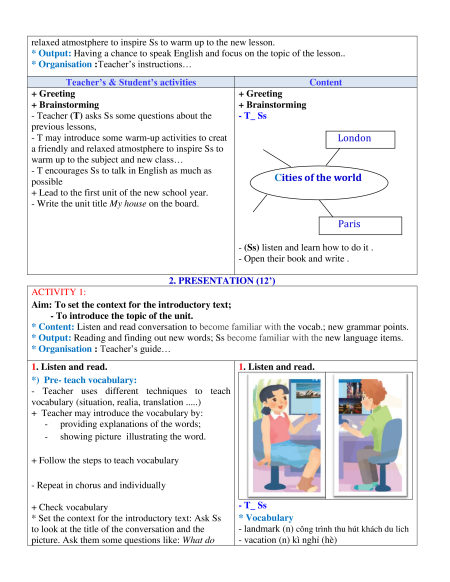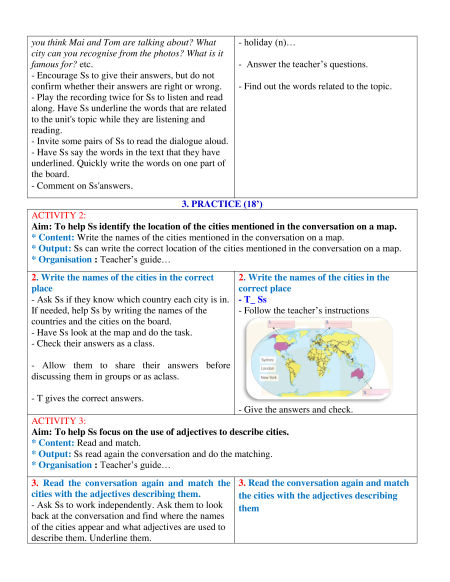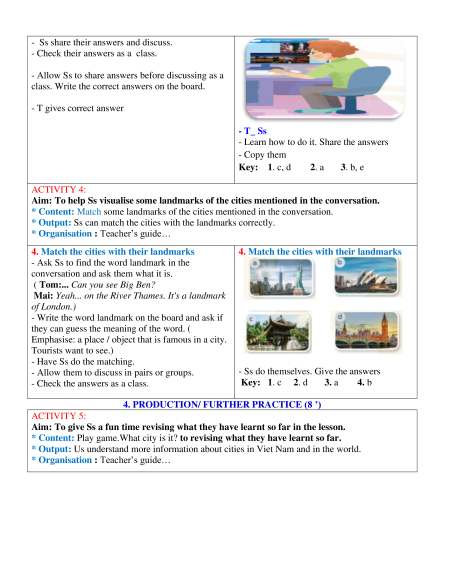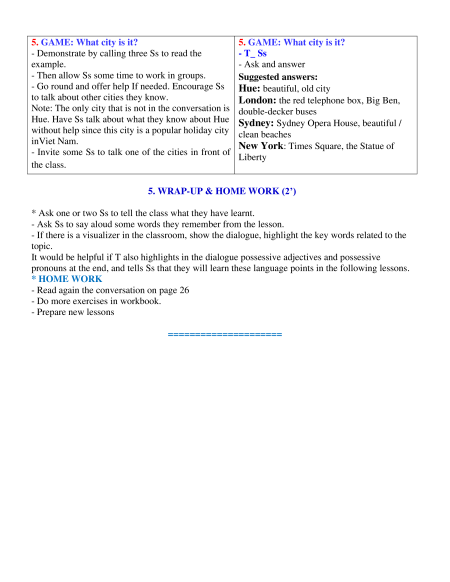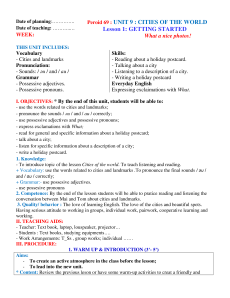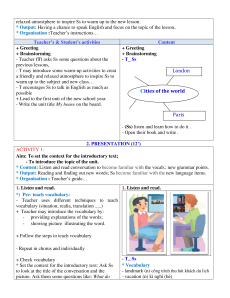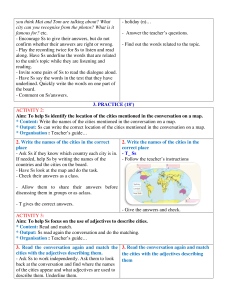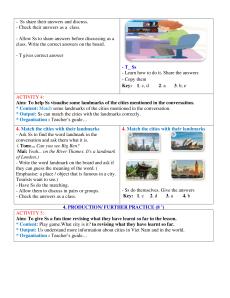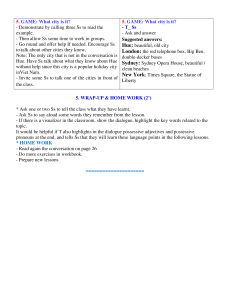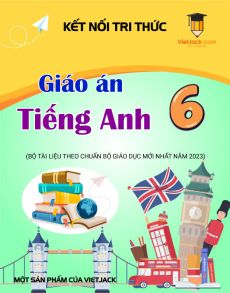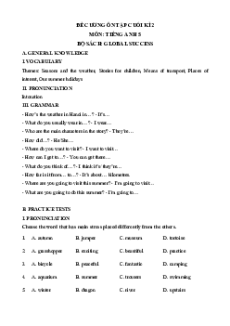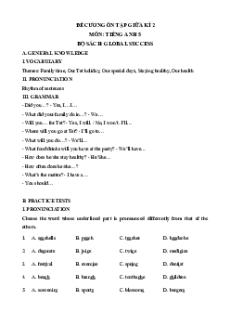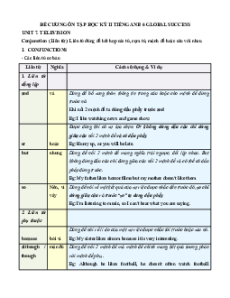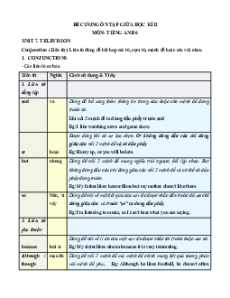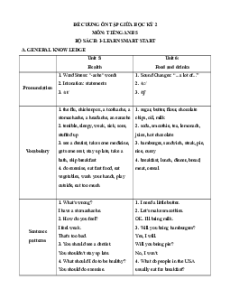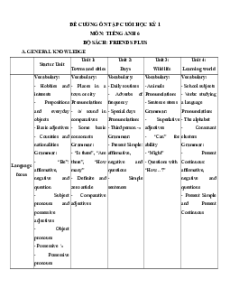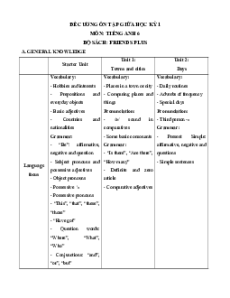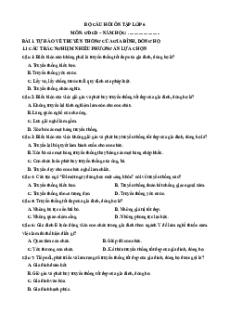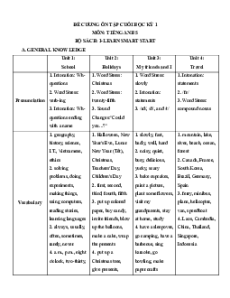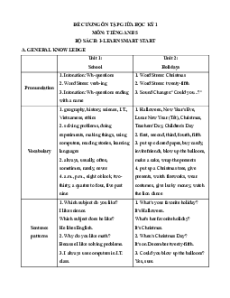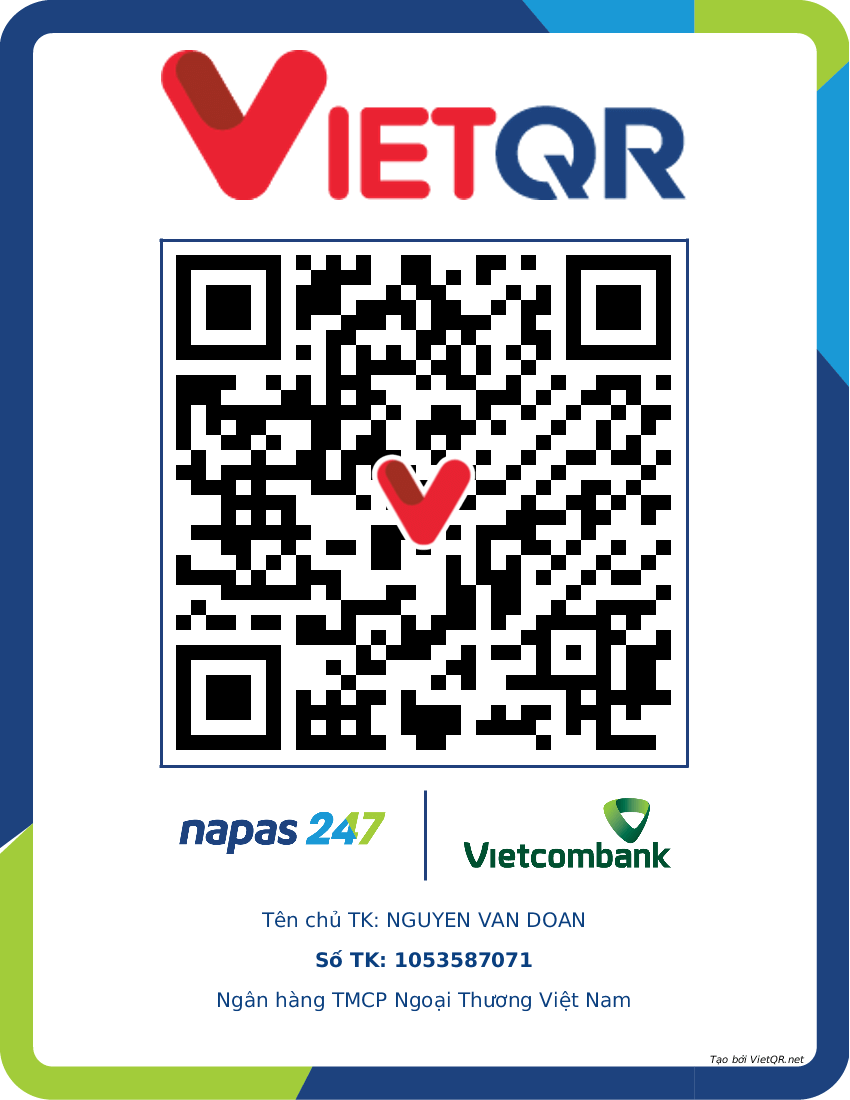Date of planning:…………..
Peroid 69 : UNIT 9 : CITIES OF THE WORLD
Date of teaching: ………..…
Lesson 1: GETTING STARTED WEEK: What a nice photos!
THIS UNIT INCLUDES: Vocabulary Skills: - Cities and landmarks
- Reading about a holiday postcard. Pronunciation: - Talking about a city
- Sounds: / әu / and / au /
- Listening to a description of a city. Grammar - Writing a holiday postcard - Possessive adjectives. Everyday English - Possessive pronouns.
Expressing exclaimations with What.
I. OBJECTIVES: * By the end of this unit, students will be able to:
- use the words related to cities and landmarks;
- pronounce the sounds / әu / and / au / correctly;
- use possessive adjectives and possessive pronouns;
- express exclamations with What;
- read for general and specific information about a holiday postcard; - talk about a city;
- listen for specific information about a description of a city; - write a holiday postcard. 1. Knowledge:
- To introduce topic of the lesson Cities of the world. To teach listening and reading.
+ Vocabulary: use the words related to cities and landmarks .To pronounce the final sounds / әu / and / au / correctly;
+ Grammar:- use possesive adjectives. - use possesive pronouns
2. Competence: By the end of the lesson students will be able to pratice reading and listening the
conversation between Mai and Tom about cities and landmarks.
3. Quality/ behavior : The love of learning English. The love of the cities and beautiful spots.
Having serious attitude to working in groups, individual work, pairwork, cooperative learning and working. II. TEACHING AIDS:
- Teacher: Text book, laptop, louspeaker, projector…
- Students : Text books, studying equipments….
- Work Arrangements: T_Ss , group works; individual …… III. PROCEDURE:
1. WARM UP & INTRODUCTION (3’- 5’) Aims:
- To create an active atmosphere in the class before the lesson;
- To lead into the new unit.
* Content: Review the previous leson or have some warm-up activities to creat a friendly and
relaxed atmostphere to inspire Ss to warm up to the new lesson.
* Output: Having a chance to speak English and focus on the topic of the lesson..
* Organisation :Teacher’s instructions…
Teacher’s & Student’s activities Content + Greeting + Greeting + Brainstorming + Brainstorming
- Teacher (T) asks Ss some questions about the - T_ Ss previous lessons,
- T may introduce some warm-up activities to creat London
a friendly and relaxed atmostphere to inspire Ss to
warm up to the subject and new class…
- T encourages Ss to talk in English as much as possible Cities of the world
+ Lead to the first unit of the new school year.
- Write the unit title My house on the board. Paris
- (Ss) listen and learn how to do it . - Open their book and write .
2. PRESENTATION (12’) ACTIVITY 1:
Aim: To set the context for the introductory text;
- To introduce the topic of the unit.
* Content: Listen and read conversation to become familiar with the vocab.; new grammar points.
* Output: Reading and finding out new words; Ss become familiar with the new language items.
* Organisation : Teacher’s guide… 1. Listen and read. 1. Listen and read. *) Pre- teach vocabulary:
- Teacher uses different techniques to teach
vocabulary (situation, realia, translation .....)
+ Teacher may introduce the vocabulary by:
- providing explanations of the words;
- showing picture illustrating the word.
+ Follow the steps to teach vocabulary
- Repeat in chorus and individually + Check vocabulary - T_ Ss
* Set the context for the introductory text: Ask Ss * Vocabulary
to look at the title of the conversation and the
- landmark (n) công trình thu hút khách du lich
picture. Ask them some questions like: What do
- vacation (n) kì nghỉ (hè)
you think Mai and Tom are talking about? What - holiday (n)…
city can you recognise from the photos? What is it famous for? etc.
- Answer the teacher’s questions.
- Encourage Ss to give their answers, but do not
confirm whether their answers are right or wrong.
- Find out the words related to the topic.
- Play the recording twice for Ss to listen and read
along. Have Ss underline the words that are related
to the unit's topic while they are listening and reading.
- Invite some pairs of Ss to read the dialogue aloud.
- Have Ss say the words in the text that they have
underlined. Quickly write the words on one part of the board. - Comment on Ss'answers. 3. PRACTICE (18’) ACTIVITY 2:
Aim: To help Ss identify the location of the cities mentioned in the conversation on a map.
* Content: Write the names of the cities mentioned in the conversation on a map.
* Output: Ss can write the correct location of the cities mentioned in the conversation on a map.
* Organisation : Teacher’s guide…
2. Write the names of the cities in the correct
2. Write the names of the cities in the place correct place
- Ask Ss if they know which country each city is in. - T_ Ss
If needed, help Ss by writing the names of the
- Follow the teacher’s instructions
countries and the cities on the board.
- Have Ss look at the map and do the task.
- Check their answers as a class.
- Allow them to share their answers before
discussing them in groups or as aclass.
- T gives the correct answers. - Give the answers and check. ACTIVITY 3:
Aim: To help Ss focus on the use of adjectives to describe cities.
* Content: Read and match.
* Output: Ss read again the conversation and do the matching.
* Organisation : Teacher’s guide…
3. Read the conversation again and match the 3. Read the conversation again and match
cities with the adjectives describing them.
the cities with the adjectives describing
- Ask Ss to work independently. Ask them to look them
back at the conversation and find where the names
of the cities appear and what adjectives are used to
describe them. Underline them.
- Ss share their answers and discuss.
- Check their answers as a class.
- Allow Ss to share answers before discussing as a
class. Write the correct answers on the board. - T gives correct answer - T_ Ss
- Learn how to do it. Share the answers - Copy them
Key: 1. c, d 2. a 3. b, e ACTIVITY 4:
Aim: To help Ss visualise some landmarks of the cities mentioned in the conversation.
* Content: Match some landmarks of the cities mentioned in the conversation.
* Output: Ss can match the cities with the landmarks correctly.
* Organisation : Teacher’s guide…
4. Match the cities with their landmarks
4. Match the cities with their landmarks
- Ask Ss to find the word landmark in the
conversation and ask them what it is.
( Tom:... Can you see Big Ben?
Mai: Yeah... on the River Thames. It's a landmark of London.)
- Write the word landmark on the board and ask if
they can guess the meaning of the word. (
Emphasise: a place / object that is famous in a city. Tourists want to see.) - Have Ss do the matching.
- Allow them to discuss in pairs or groups.
- Ss do themselves. Give the answers
- Check the answers as a class.
Key: 1. c 2. d 3. a 4. b
4. PRODUCTION/ FURTHER PRACTICE (8 ’) ACTIVITY 5:
Aim: To give Ss a fun time revising what they have learnt so far in the lesson.
* Content: Play game.What city is it? to revising what they have learnt so far.
* Output: Us understand more information about cities in Viet Nam and in the world.
* Organisation : Teacher’s guide…
Giáo án Unit 9: Cities of the world Tiếng Anh 6 Global success
1 K
502 lượt tải
MUA NGAY ĐỂ XEM TOÀN BỘ TÀI LIỆU
CÁCH MUA:
- B1: Gửi phí vào TK:
1133836868- CT TNHH DAU TU VA DV GD VIETJACK - Ngân hàng MB (QR) - B2: Nhắn tin tới Zalo VietJack Official ( nhấn vào đây ) để xác nhận thanh toán và tải tài liệu - giáo án
Liên hệ ngay Hotline hỗ trợ: 084 283 45 85
Bộ giáo án Tiếng anh 6 Global success được cập nhật liên tục trong gói này từ nay đến hết tháng 3/2024.
Để tải tài liệu gốc về máy bạn click vào nút Tải Xuống ở trên!
Thuộc bộ (mua theo bộ để tiết kiệm hơn):
- Bộ giáo án Tiếng anh 6 Global success năm 2023 mới, chuẩn nhất được thiết kế theo phong cách hiện đại, đẹp mắt, trình bày chi tiết cho từng bài học và bám sát chương trình Sách giáo khoa Tiếng anh 6 Global success.
- Mua trọn bộ sẽ tiết kiệm hơn tải lẻ 50%.
Đánh giá
4.6 / 5(1004 )5
4
3
2
1
Trọng Bình
Tài liệu hay
Giúp ích cho tôi rất nhiều
Duy Trần
Tài liệu chuẩn
Rất thích tài liệu bên VJ soạn (bám sát chương trình dạy)
TÀI LIỆU BỘ BÁN CHẠY MÔN Tiếng Anh
Xem thêmTÀI LIỆU BỘ BÁN CHẠY Lớp 6
Xem thêmTài liệu bộ mới nhất

Date of planning:…………..
Date of teaching: ………..…
WEEK:
Peroid 69 : UNIT 9 : CITIES OF THE WORLD
Lesson 1: GETTING STARTED
What a nice photos!
THIS UNIT INCLUDES:
Vocabulary
- Cities and landmarks
Pronunciation:
- Sounds: / әu / and / au /
Grammar
- Possessive adjectives.
- Possessive pronouns.
Skills:
- Reading about a holiday postcard.
- Talking about a city
- Listening to a description of a city.
- Writing a holiday postcard
Everyday English
Expressing exclaimations with What.
I. OBJECTIVES: * By the end of this unit, students will be able to:
- use the words related to cities and landmarks;
- pronounce the sounds / әu / and / au / correctly;
- use possessive adjectives and possessive pronouns;
- express exclamations with What;
- read for general and specific information about a holiday postcard;
- talk about a city;
- listen for specific information about a description of a city;
- write a holiday postcard.
1. Knowledge:
- To introduce topic of the lesson Cities of the world. To teach listening and reading.
+ Vocabulary: use the words related to cities and landmarks .To pronounce the final sounds / әu /
and / au / correctly;
+ Grammar:- use possesive adjectives.
- use possesive pronouns
2. Competence: By the end of the lesson students will be able to pratice reading and listening the
conversation between Mai and Tom about cities and landmarks.
3. Quality/ behavior : The love of learning English. The love of the cities and beautiful spots.
Having serious attitude to working in groups, individual work, pairwork, cooperative learning and
working.
II. TEACHING AIDS:
- Teacher: Text book, laptop, louspeaker, projector…
- Students : Text books, studying equipments….
- Work Arrangements: T_Ss , group works; individual ……
III. PROCEDURE:
1. WARM UP & INTRODUCTION (3’- 5’)
Aims:
- To create an active atmosphere in the class before the lesson;
- To lead into the new unit.
* Content: Review the previous leson or have some warm-up activities to creat a friendly and

relaxed atmostphere to inspire Ss to warm up to the new lesson.
* Output: Having a chance to speak English and focus on the topic of the lesson..
* Organisation :Teacher’s instructions…
Teacher’s & Student’s activities
Content
+ Greeting
+ Brainstorming
- Teacher (T) asks Ss some questions about the
previous lessons,
- T may introduce some warm-up activities to creat
a friendly and relaxed atmostphere to inspire Ss to
warm up to the subject and new class…
- T encourages Ss to talk in English as much as
possible
+ Lead to the first unit of the new school year.
- Write the unit title My house on the board.
+ Greeting
+ Brainstorming
- T_ Ss
- (Ss) listen and learn how to do it .
- Open their book and write .
2. PRESENTATION (12’)
ACTIVITY 1:
Aim: To set the context for the introductory text;
- To introduce the topic of the unit.
* Content: Listen and read conversation to become familiar with the vocab.; new grammar points.
* Output: Reading and finding out new words; Ss become familiar with the new language items.
* Organisation : Teacher’s guide…
1. Listen and read.
*) Pre- teach vocabulary:
- Teacher uses different techniques to teach
vocabulary (situation, realia, translation .....)
+ Teacher may introduce the vocabulary by:
- providing explanations of the words;
- showing picture illustrating the word.
+ Follow the steps to teach vocabulary
- Repeat in chorus and individually
+ Check vocabulary
* Set the context for the introductory text: Ask Ss
to look at the title of the conversation and the
picture. Ask them some questions like: What do
1. Listen and read.
- T_ Ss
* Vocabulary
- landmark (n) công trình thu hút khách du lich
- vacation (n) kì nghỉ (hè)
Cities of the world
London
Paris

you think Mai and Tom are talking about? What
city can you recognise from the photos? What is it
famous for? etc.
- Encourage Ss to give their answers, but do not
confirm whether their answers are right or wrong.
- Play the recording twice for Ss to listen and read
along. Have Ss underline the words that are related
to the unit's topic while they are listening and
reading.
- Invite some pairs of Ss to read the dialogue aloud.
- Have Ss say the words in the text that they have
underlined. Quickly write the words on one part of
the board.
- Comment on Ss'answers.
- holiday (n)…
- Answer the teacher’s questions.
- Find out the words related to the topic.
3. PRACTICE (18’)
ACTIVITY 2:
Aim: To help Ss identify the location of the cities mentioned in the conversation on a map.
* Content: Write the names of the cities mentioned in the conversation on a map.
* Output: Ss can write the correct location of the cities mentioned in the conversation on a map.
* Organisation : Teacher’s guide…
2. Write the names of the cities in the correct
place
- Ask Ss if they know which country each city is in.
If needed, help Ss by writing the names of the
countries and the cities on the board.
- Have Ss look at the map and do the task.
- Check their answers as a class.
- Allow them to share their answers before
discussing them in groups or as aclass.
- T gives the correct answers.
2. Write the names of the cities in the
correct place
- T_ Ss
- Follow the teacher’s instructions
- Give the answers and check.
ACTIVITY 3:
Aim: To help Ss focus on the use of adjectives to describe cities.
* Content: Read and match.
* Output: Ss read again the conversation and do the matching.
* Organisation : Teacher’s guide…
3. Read the conversation again and match the
cities with the adjectives describing them.
- Ask Ss to work independently. Ask them to look
back at the conversation and find where the names
of the cities appear and what adjectives are used to
describe them. Underline them.
3. Read the conversation again and match
the cities with the adjectives describing
them

- Ss share their answers and discuss.
- Check their answers as a class.
- Allow Ss to share answers before discussing as a
class. Write the correct answers on the board.
- T gives correct answer
- T_ Ss
- Learn how to do it. Share the answers
- Copy them
Key: 1. c, d 2. a 3. b, e
ACTIVITY 4:
Aim: To help Ss visualise some landmarks of the cities mentioned in the conversation.
* Content: Match some landmarks of the cities mentioned in the conversation.
* Output: Ss can match the cities with the landmarks correctly.
* Organisation : Teacher’s guide…
4. Match the cities with their landmarks
- Ask Ss to find the word landmark in the
conversation and ask them what it is.
( Tom:... Can you see Big Ben?
Mai: Yeah... on the River Thames. It's a landmark
of London.)
- Write the word landmark on the board and ask if
they can guess the meaning of the word. (
Emphasise: a place / object that is famous in a city.
Tourists want to see.)
- Have Ss do the matching.
- Allow them to discuss in pairs or groups.
- Check the answers as a class.
4. Match the cities with their landmarks
- Ss do themselves. Give the answers
Key: 1. c 2. d 3. a 4. b
4. PRODUCTION/ FURTHER PRACTICE (8 ’)
ACTIVITY 5:
Aim: To give Ss a fun time revising what they have learnt so far in the lesson.
* Content: Play game.What city is it? to revising what they have learnt so far.
* Output: Us understand more information about cities in Viet Nam and in the world.
* Organisation : Teacher’s guide…

5. GAME: What city is it?
- Demonstrate by calling three Ss to read the
example.
- Then allow Ss some time to work in groups.
- Go round and offer help If needed. Encourage Ss
to talk about other cities they know.
Note: The only city that is not in the conversation is
Hue. Have Ss talk about what they know about Hue
without help since this city is a popular holiday city
inViet Nam.
- Invite some Ss to talk one of the cities in front of
the class.
5. GAME: What city is it?
- T_ Ss
- Ask and answer
Suggested answers:
Hue: beautiful, old city
London: the red telephone box, Big Ben,
double-decker buses
Sydney: Sydney Opera House, beautiful /
clean beaches
New York: Times Square, the Statue of
Liberty
5. WRAP-UP & HOME WORK (2’)
* Ask one or two Ss to tell the class what they have learnt.
- Ask Ss to say aloud some words they remember from the lesson.
- If there is a visualizer in the classroom, show the dialogue, highlight the key words related to the
topic.
It would be helpful if T also highlights in the dialogue possessive adjectives and possessive
pronouns at the end, and tells Ss that they will learn these language points in the following lessons.
* HOME WORK
- Read again the conversation on page 26
- Do more exercises in workbook.
- Prepare new lessons
=====================
